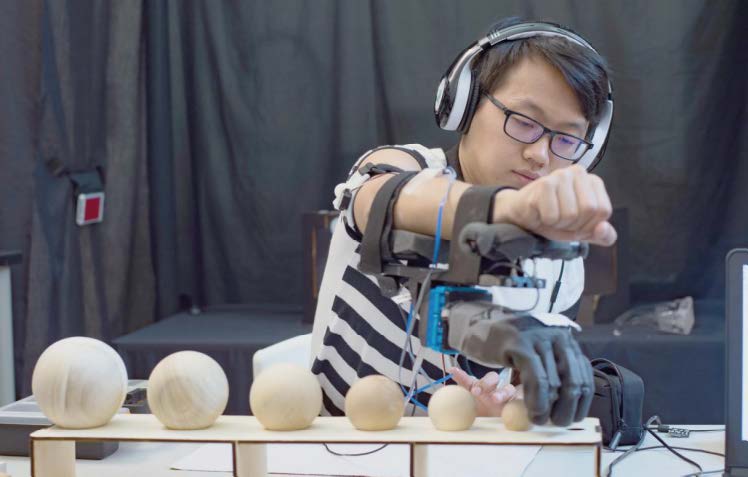Tactile Feedback Adds “Muscle Sense” to Prosthetic Hand
Engineers working to add “muscle sense” to prosthetic limbs found that tactile feedback on the skin allowed blindfolded test subjects to more than double their ability to discern the size of objects grasped with a prosthetic hand. The results will be presented in June, in Germany, by researchers from Rice University and the Research Center “E.Piaggio” of the University of Pisa and the Italian Institute of Technology (IIT). “Humans have an innate sense of how the parts of their bodies are positioned, even if they can’t see them,” said Marcia O’Malley, professor of mechanical engineering at Rice. “This ‘muscle sense’ is what allows people to type on a keyboard, hold a cup, throw a ball, use a brake pedal and do countless other daily tasks.”
The scientific term for this muscle sense is proprioception, and O’Malley’s Mechatronics and Haptic Interfaces Lab (MAHI) has worked for years to develop technology that would allow amputees to receive proprioceptive feedback from artificial limbs.
In a new paper to be presented June 7 at the World Haptics 2017 conference in Fürstenfeldbruck, Germany, O’Malley and colleagues demonstrate that 18 able-bodied test subjects performed significantly better on size-discrimination tests with a prosthetic hand when they received haptic feedback from a simple skin-stretch device on the upper arm. The study is the first to test a prosthesis in combination with a skinstretch rocking device for proprioception, and the work has been recognized as a finalist for best paper award at the conference. An estimated 1.7 million people in the U.S. live with the loss of a limb. Traditional prostheses restore some day-to-day function, but very few provide sensory feedback. For the most part, an amputee today must see their prosthesis to properly operate it.
Improved computer processors, inexpensive sensors, vibrating motors from cellphones and other electronics have created new possibilities for adding tactile feedback, also known as haptics, to prosthetics, and O’Malley’s lab has done research in this area for more than a decade. “We’ve been limited to testing haptic feedback with simple grippers or virtual environments that replicate what amputees experience,” she said. “That changed when I was contacted last year by representatives of Antonio Bicchi’s research group at Pisa and IIT who were interested in testing their prosthetic hand with our haptic feedback system.” In experiments at Rice beginning late last year, Pisan graduate student Edoardo Battaglia and Rice graduate student Janelle Clark tested MAHI’s Rice Haptic Rocker in conjunction with the Pisa/IIT SoftHand. They measured how well blindfolded subjects could distinguish the size of grasped objects both with and without proprioceptive feedback.
While some proprioceptive technologies require surgically implanted electrodes, the Rice Haptic Rocker has a simple, noninvasive user interface – a rotating arm that brushes a soft rubber pad over the skin of the arm. At rest, when the prosthetic hand is fully open, the rocker arm does not stretch the skin. As the hand closes, the arm rotates, and the more the hand closes, the greater the skin is stretched. “We’re using the tactile sensation on the skin as a replacement for information the brain would normally get from the muscles about hand position,” Clark said. “We’re essentially mapping from feedback from one source onto an aspect of the prosthetic hand. In this case, it’s how much the hand is open or closed.”
Like the Rice Haptic Rocker, the SoftHand uses a simple design. Co-creator Manuel Catalano, a postdoctoral research scientist at IIT/Pisa, said the design inspiration comes from neuroscience. “Human hands have many joints and articulations, and reproducing and controlling that in a robotic hand is very difficult,” he said.

FINISHING TOUCH: “We’re using the tactile sensation on the skin as a replacement for information the brain would normally get from the muscles about hand position,” Janelle Clark said. "We’re essentially mapping from feedback from one source onto an aspect of the prosthetic hand.”
“The Rice Haptic Rocker has a simple, noninvasive user interface – a rotating arm that brushes a soft rubber pad over the skin of the arm.”